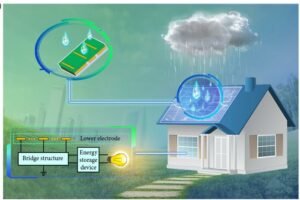In a potentially game-changing breakthrough in energy harvesting, researchers have found a way to capture, store and utilize the electrical power generated by falling raindrops, which may lead to the development of rooftop, power-generating rain panels.
Previous attempts to generate power from failing rain have run into specific technical hurdles that often seemed impossible to surpass, but the researchers behind this new method say they have found a solution that may finally make such rain panels as popular, if not more so, than solar panels.
Rain Panels Suffer From Technical Limitations
Engineers have long known about the potential power generation capabilities of fallen raindrops. The idea is already in practical applications like hydroelectric dams and wave power collection systems, where the movement of the water generates electricity.
However, the efforts to collect energy from falling raindrops have faced a technical hurdle that has made the concept inefficient and impractical. By using something called a triboelectric nanogenerator (TENG), engineers can collect the tiny but measurable amount of electricity generated by a falling raindrop, but as one might expect, the amount of power per raindrop is incredibly small.
In technologies like solar panels ( or even the “nighttime anti-solar panels” The Debrief previously covered), a similar problem is overcome by combining a series of individual solar cells in a single circuit, resulting in a full panel of cells that can collect a larger amount of energy together. Unfortunately, this simply doesn’t work for individual raindrop power collection cells due to a phenomenon called “coupling capacitance” that occurs between the upper and lower electrodes of each cell. As a result, power loss is too great from cell to cell, making the idea of building a full-blown rain panel seemingly impossible.
Now, a team of researchers says they have found a design and configuration that greatly reduces the coupling capacitance issue and one they claim could make energy-harvesting rain panels a practical reality.
Building the Backbone for the World’s First Energy Collecting Rain Panels
“Although D-TENGs have ultra-high instantaneous output power, it is still difficult for a single D-TENG to continuously supply power for megawatt-level electrical equipment. Therefore, it is very important to realize the simultaneous utilization of multiple D-TENGs,” said Zong Li, one of the authors of the proposed method and a professor at the Tsinghua Shenzhen International Graduate School. “Referring to the design of solar panels in which multiple solar power generation units are connected in parallel to supply the load, we are proposing a simple and effective method for raindrop energy harvesting.”
To make their system able to overcome the coupling capacitance issue, Li and his team proposed something called “bridge array generators” that use lower array electrodes to keep the cells operating separately while reducing the capacitance.
Published in the journal iEnergy, the process seems promising, offering a new way to arrange individual cells into a series array that can collect and store the energy for practical uses.


“When the droplet falls on the surface of the panel, called the FEP surface, the droplet becomes positively charged, and the FEP surface negatively charged,” explains the press release announcing the research. This charge, Li explains, is so small that after a period of time, it will begin to dissipate, leading to energy loss. However, by adding their new bridge array generators into the formula, they say they have overcome this issue.
“After a long time on the surface, the charges on the FEP surface will gradually accumulate to saturation,” said Li. “At this point, the dissipation rate of the FEP’s surface charge is balanced with the amount of charge generated by each impact of the droplet.”
After their initial success, Li and the team tried different bridge array generators, different sizes of sub-electrodes and even experimented with varying the size of the panel itself. According to the researchers, increasing the thickness of the FEP surface “led to decreased coupling capacitance while maintaining the surface charge density, both of which could improve the performance of the bridge array generator.”
Turning the Process into Practical Power Collection and Storage
Ultimately, the team says they zeroed in on what they think is the most optimal design to make rain panels a practical alternative or supplement to solar panels. Specifically, making the individual cells work independently and finding the right surface thickness seemed to reduce the coupling capacitance enough to make power collection from rain panels viable.
“The peak power output of the bridge array generators is nearly 5 times higher than that of the conventional large-area raindrop energy with the same size, reaching 200 watts per square meter,” Li explained, “which fully shows its advantages in large-area raindrop energy harvesting.”
“The results of this study will provide a feasible scheme for large-area raindrop energy harvesting,” he added.
Christopher Plain is a Science Fiction and Fantasy novelist and Head Science Writer at The Debrief. Follow and connect with him on X, learn about his books at plainfiction.com, or email him directly at christopher@thedebrief.org.

